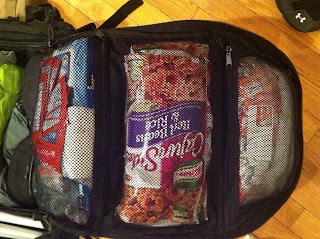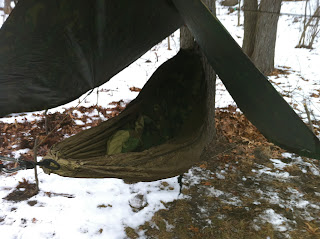Essentially we're talking about a bag that can sustain you for at least 3 days while on the move. Bags come in all different shapes and sizes. Tactical, not tactical, commercial and the Tacticool. Keep in mind you're going to have carry the darned thing around with you for a few days. So keep your choices appropriate.
 |
| Authors "Winter Bag" |
Toiletries include a roll of TP with the cardboard tube cut out and the roll "flattened", a package of baby wipes, toothpaste, toothbrush and Super Body Care® Body spray. The SBC spray is a cleanser, disinfectant and refresher all in one and best of all...it is completely ORGANIC. I will be adding the SBC body wipes as soon as they arrive to replace the baby wipes.
 |
| Hygiene-Food Pantry-Condiments |
My food pantry begins right above the toiletries. I have various of those "just add water" and boil, rice and noodle dishes that are high calorie and provide me with energy if I'm on foot. A simple matter of boiling water and adding the pouch and letting it simmer down. Cheaper than those expensive "dehydrated meals" and easy on the palate. I also have various jerky meats and fully cooked BACON! Above the meals is my "snivel" pouch. It contains salt, pepper, hot, mild and soy sauces, sugars, jellies, etc to add a little variety to my foods.
The next compartment contains my sheltering kit. Essentially a 8.5 X 6 foot tarp, some bungees and 550 paracord. Unseen are 6 alloy ground stakes. Additionally The green and silver tarp you see is a "survival blanket". My fire kit and spare sporks and some Gator Chews round it out.
Outside pouch #1 is attached via MOLLE and it contains my "right now" pantry. I can make a quick fire and get some hot wets going righ away without having to open up the main compartment of the bag. It contains: Ramen Noodles, Jerky, Hot Cocoa, Oatmeal, and of course coffee. VIA from Starbuck's to be precise because it's boil and drink and comes conveniently packaged. There are also some limited condiments to add some kick to the noodles.
 |
| Nalgene® Water Bottle Carrier and Fire Kit1 |
 |
| Guyot Designs Nalgene® STEEL Bottle |
Other items in my bag are an EnO Hammock with straps, spare gloves, flashlight, compass, and GPS. I attach my sleeping bag or a thick 100% Wool blanket to the bottom via MOLLE and I'm all set.
The whole pack weighs in under 45 pounds and it can travel relatively long distances before causing fatigue, which is key when setting up these bags. This one is primarily set up for winter time usage I have another which is my "3 season" bag. Which I'll go over at a later date.
Main Pack:
Super Body Care Products ( Highly Recommended):










